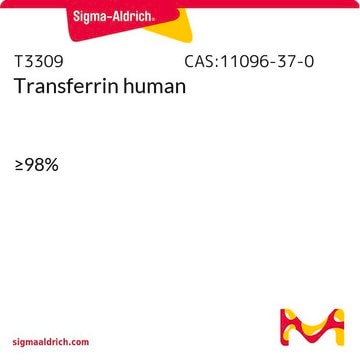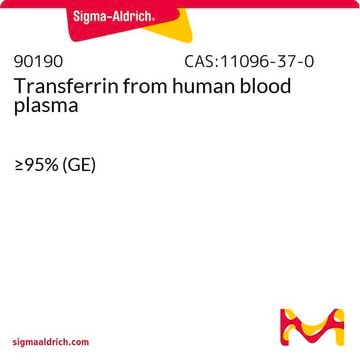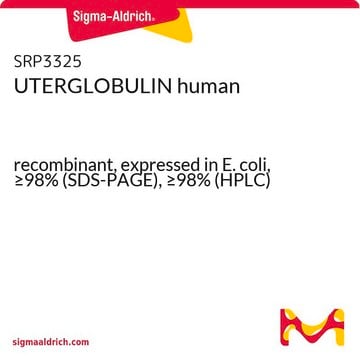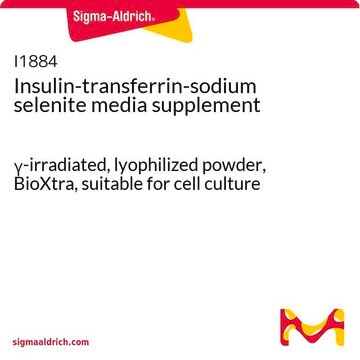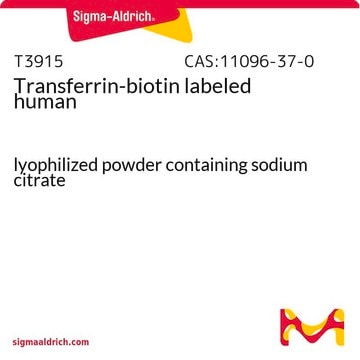10652202001
Roche
Transferrin
from human serum
Synonym(s):
serum glycoprotein, transferrin
Sign Into View Organizational & Contract Pricing
All Photos(1)
About This Item
UNSPSC Code:
12352207
Recommended Products
General description
Transferrin is a serum glycoprotein that participates in the transport of iron from absorption and storage sites to tissue cells. The iron-bound transferrin, also referred to as ferrotransferrin, binds to specific cell surface receptors on growing cells and are internalized by endocytosis. Once inside, the iron is released into the cells and the iron-free transferrin, also referred to as apotransferrin, is exocytosed outside the cell without being degraded.
Application
Transferrin, similar to insulin, is a component of most serum-free media formulations. The main function of transferrin is to transport iron into cells by receptor-mediated endocytosis.
Transferrin from human serum has been used as a supplement in:
Transferrin from human serum has been used as a supplement in:
- differentiation medium
- keratinocyte medium
- haemogenic endothelium culture medium
- embryoid-body medium
- blast colony forming cell-culture medium
Physical form
Solution, 30 mg/ml in IMDM, filtered through 0.2 μm pore size membrane. Iron saturation is below 1%. This product is Apo-Transferrin.
Preparation Note
Working concentration: 1 to 100 μg/ml
Storage and Stability
Store at 2 to 8 °C. (lyophilizate and solution)
Other Notes
For life science research only. Not for use in diagnostic procedures.
WGK
WGK 1
Flash Point(F)
No data available
Flash Point(C)
No data available
Certificates of Analysis (COA)
Search for Certificates of Analysis (COA) by entering the products Lot/Batch Number. Lot and Batch Numbers can be found on a product’s label following the words ‘Lot’ or ‘Batch’.
Already Own This Product?
Find documentation for the products that you have recently purchased in the Document Library.
Customers Also Viewed
Quantification of Mouse Hematopoietic Progenitors? Formation Using Time-lapse Microscopy and Image Analysis
Bergiers I, et al.
Bio-protocol, 9(1), e3137-e3137 (2019)
Özge Vargel et al.
Scientific reports, 6, 21518-21518 (2016-02-20)
The endothelial to haematopoietic transition (EHT) is a key developmental process where a drastic change of endothelial cell morphology leads to the formation of blood stem and progenitor cells during embryogenesis. As TGFβ signalling triggers a similar event during embryonic
Iron deficiency affects early stages of embryonic hematopoiesis but not the
endothelial to hematopoietic transition.
endothelial to hematopoietic transition.
Shvartsman M, et al.
bioRxiv (2018)
Renata M Martin et al.
Nature communications, 11(1), 2713-2713 (2020-06-03)
Despite their rapidly-expanding therapeutic potential, human pluripotent stem cell (hPSC)-derived cell therapies continue to have serious safety risks. Transplantation of hPSC-derived cell populations into preclinical models has generated teratomas (tumors arising from undifferentiated hPSCs), unwanted tissues, and other types of
Zhiru Guo et al.
Journal of visualized experiments : JoVE, (49)(49), doi:10-doi:10 (2011-04-15)
The homeostasis of all self-renewing tissues is dependent on adult stem cells. As undifferentiated stem cells undergo asymmetric divisions, they generate daughter cells that retain the stem cell phenotype and transit-amplifying cells (TA cells) that migrate from the stem cell
Our team of scientists has experience in all areas of research including Life Science, Material Science, Chemical Synthesis, Chromatography, Analytical and many others.
Contact Technical Service


